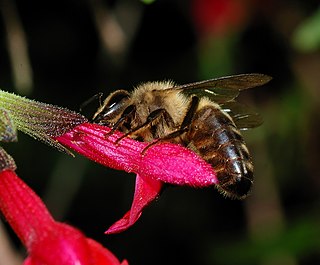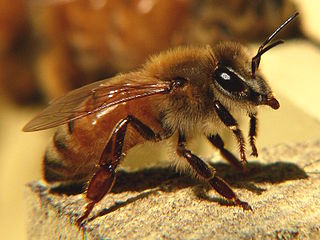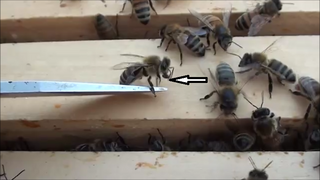Related Research Articles

The Africanized bee, also known as the Africanized honey bee (AHB) and colloquially as the "killer bee", is a hybrid of the western honey bee, produced originally by crossbreeding of the East African lowland honey bee (A. m. scutellata) with various European honey bee subspecies such as the Italian honey bee (A. m. ligustica) and the Iberian honey bee (A. m. iberiensis).
Within biological taxonomy, a honey bee race would be an informal rank in the taxonomic hierarchy, below the level of subspecies. It has been used as a higher rank than strain, with several strains making up one race. Therefore, a strain is a lower-level taxonomic rank used at the intraspecific level within a race of a subspecies. Strains are often seen as inherently artificial concepts, more usually within biology as characterized by a specific intent for genetic isolation, however, within beekeeping circles, strain is more likely to be used to describe very minor differences throughout the same subspecies, such as the color ranges of A. m. carnica from brown to grey. Within A. m. ligustica there are two races, the darker leather brown northern Italian bee from the Ligurian Alps region which was discovered to be resistant to acarine in the 1900s, while the other Italian bee race, from regions near Bologna and further south, was highly susceptible to acarine and within this race there are two color strains, the traditional Italian yellow and a rarer all-golden color.

The Apis mellifera mellifera is a subspecies of the western honey bee, evolving in central Asia, with a proposed origin of the Tien Shan Mountains and later migrating into eastern and then northern Europe after the last ice age from 9,000BC onwards. Its original range included the southern Urals in Russia and stretched through northern Europe and down to the Pyrenees. They are one of the two members of the 'M' lineage of Apis mellifera, the other being in western China. Traditionally they were called the Black German Bee, although they are now considered endangered in Germany. However today they are more likely to be called after the geographic / political region in which they live such as the British Black Bee, the Native Irish Honey Bee, the Cornish Black Bee and the Nordic Brown Bee, even though they are all the same subspecies, with the word "native" often inserted by local beekeepers, even in places where the bee is an introduced foreign species. It was domesticated in Europe and hives were brought to North America in the colonial era in 1622 where they were referred to as the English Fly by the Native Americans.

Apis mellifera ligustica is the Italian bee or the Italian Honey bee which is a subspecies of the western honey bee.

The Caucasian honey bee is a subspecies of the western honey bee.

Varroa is a genus of parasitic mesostigmatan mites associated with honey bees, placed in its own family, Varroidae. The genus was named for Marcus Terentius Varro, a Roman scholar and beekeeper. The condition of a honeybee colony being infested with Varroa mites is called varroosis.

Karl Kehrle OSB OBE, known as Brother Adam, was a Benedictine monk, beekeeper, and an authority on bee breeding, developer of the Buckfast bee.
"He was unsurpassed as a breeder of bees. He talked to them, he stroked them. He brought to the hives a calmness that, according to those who saw him at work, the sensitive bees responded to." – The Economist, 14 September 1996
The Maltese honey bee, Apis mellifera ruttneri, is a subspecies of the western honey bee, endemic to the Maltese islands which are situated in the Mediterranean Sea.

The western honey bee or European honey bee is the most common of the 7–12 species of honey bees worldwide. The genus name Apis is Latin for "bee", and mellifera is the Latin for "honey-bearing" or "honey carrying", referring to the species' production of honey.

Commercial Beekeeping in the United States dates back to the 1860s.
Robert "Bert" Orlando Beater Manley was a British farmer and beekeeper, an authority on commercial honey farming and developer of the popular Manley moveable frame hives and frame systems.
Varroa sensitive hygiene (VSH) is a behavioral trait of honey bees (Apis mellifera) in which bees detect and remove bee pupae that are infested by the parasitic mite Varroa destructor. V. destructor is considered to be the most dangerous pest problem for honey bees worldwide. VSH activity results in significant resistance to the mites.
Beekeeping is first recorded in Ireland in the seventh century. It has seen a surge in popularity in modern times, with the membership of beekeeping associations exceeding 4,500. The median average number of hives per beekeeper is three hives, while the average honey output per hive is 11.4 kg. The growth in the practice has occurred despite increased pressures on bees and beekeepers due to parasites, diseases and habitat loss.
Beekeeping in the United Kingdom is the maintenance of bee colonies by humans within the United Kingdom. It is a significant commercial activity that provides those involved with honey, beeswax, royal jelly, queen bees, propolis, flower pollen and bee pollen. Honeybees also provide pollination services to orchards and a variety of seed crops.

Apis mellifera cecropia, the Greek bee, is the subspecies of honey bee that is native to southern Greece. It is found also in southern Albania, and it is very similar to Apis mellifera ligustica, the Italian bee. it is favored for its extreme gentleness and lack of tendency to swarm. The Greek bee originates in Greece where the climate is Mediterranean, and cannot survive in the north of Europe where the climate is cooler, and because of that they are not spread around the world much by commercial beekeepers. They are mainly only kept in southern Greece.

Mite Biting Is one of the behavioral mechanisms of honey bees used to fight off the ectoparasitic mites Varroa destructor. This behavior has been studied since the late 1990s for honey bee breeding and improvement of honeybee stocks towards mite resistance. Krispn Given and Dr. Greg Hunt at Purdue University started a hierarchical selective breeding program in 1997–present for increased mite-biting and grooming behavior of European honey bee. A group of Midwest bee breeders visiting the Purdue bee lab were inspired to start the Heartland Honey Bee Breeders Cooperative as a result of their pioneering work.
Apis mellifera monticola is known by the common name of the East African mountain honey bee. In 2017 its complete mitochondrial genome was sequenced, confirming that it belonged to the A Lineage of honey bees and concluding that "A phylogenetic tree showed that A. m. monticola clusters with other African subspecies".

Apis mellifera syriaca is known by the common name of the Syrian honey bee, sometimes also called the Palestine honey bee.
References
- ↑ "Gemeinschaft der europäischen Buckfastimker e.V." Federation of European Buckfast beekeepers.
- ↑ "Honeybee Queens Pedigrees".
- ↑ "Origin of the Buckfast Strain, described by Brother Adam". Karl Kehrle Fondation. Jean-Marie Van Dyck. Retrieved 7 December 2018.
- ↑ "Buckfast European Breeders – UK – Brother Adam, Pedigrees". Karl Kehrle Fondation. Jean-Marie Van Dyck. Retrieved 7 December 2018.
- ↑ "Fehrenbach mountain mating station (DE)". Karl Kehrle Foundation. Retrieved 7 December 2018.
- ↑ "Gemeinschaft der europäischen Buckfastimker e.V." Federation of European Buckfast beekeepers.
- ↑ "The Origin of the Buckfast Honey Bee – Brother Adam". pedigreeapis.org. Archived from the original on 13 April 2016. Retrieved 12 February 2014.
- ↑ Brother Adam, Beekeeping at Buckfast Abbey, (Northern Bee Books, 1987), 12.
- ↑ "Federation – Buckfast Breeding Regulations, point 3.1" (PDF). gdeb.eu.
- ↑ Brother Adam O.B.E. (1975). Beekeeping at Buckfast Abbey (first ed.). British Bee Publications. pp. 52–53.
- ↑ Brother Adam O.B.E. (1975). Beekeeping at Buckfast Abbey (first ed.). British Bee Publications. pp. 54–57.
- ↑ Stephen John Martin, Hisashi Okuyama, John Hill & Jun-ichi Takahashi (2018). "The complete mitochondrial genome of a Buckfast bee" (PDF). Mitochondrial DNA Part B. 3 (1): 338–339. doi: 10.1080/23802359.2018.1450660 . PMC 7800400 . PMID 33490507.
{{cite journal}}: CS1 maint: multiple names: authors list (link) - ↑ Brother Adam O.B.E. (1975). Beekeeping at Buckfast Abbey (first ed.). British Bee Publications. pp. 57–59.
- ↑ H. Okuyama, J. Hill, S. J. Martin & J. Takahashi (2018). "The complete mitochondrial genome of a Buckfast bee, Apis mellifera in Northern Ireland". Mitochondrial DNA Part B. 3 (#1): 338–339. doi: 10.1080/23802359.2018.1450660 . PMC 7800400 . PMID 33490507 . Retrieved 21 November 2018.
{{cite journal}}: CS1 maint: multiple names: authors list (link) - ↑ Brother Adam O.B.E. (1975). Beekeeping at Buckfast Abbey (first ed.). British Bee Publications. p. 11.
- ↑ K. Olszewski, G. Borsuk, J. Paleolog, A. Strachecka (2012). "Evaluation of economic traits in Buckfast bees in comparison with the hybrids of European Black bees and Caucasian bees". Annales Universitatis Mariae Curie-Sk Ł Odowska Lublin – Polonia. 30 (#2): 44–52. Retrieved 22 November 2018.
{{cite journal}}: CS1 maint: multiple names: authors list (link) - ↑ J. Paleolog, K. Olszewski (2005). "Foraging and hoarding efficiency in Buckfast purebreds and Norwegian black bee (A. m. mellifera) Hybrids Part 2. Comparison with the caucasian bee hybrids under flying cage and laboratory test conditions". Journal of Apicultural Science. 49 (#1): 27–39.
- ↑ Brother Adam O.B.E. (1975). Beekeeping at Buckfast Abbey (first ed.). British Bee Publications. pp. 49–51.
- ↑ Oddie, Melissa A.Y.; Dahle, Bjørn; Neumann, Peter (2017). "Norwegian honey bees surviving Varroa destructor mite infestations by means of natural selection". PeerJ. 5: e3956. doi: 10.7717/peerj.3956 . PMC 5659219 . PMID 29085753.
- ↑ "PJ-11 – Honeybee Pedigree of Paul Jungels (LU) – 2011".
- ↑ B. Fernhout. "Buckfast VSH – Single Drone Project – 2014 Results" (PDF). aristabeeresearch.org. Stichting Arista Bee Research. Retrieved 22 November 2018.
- ↑ Dr. Peter Stöfen. "REPORTS: NEW: "Hygiene"-Buckfast Queens". buckfast-zucht.de. Retrieved 29 December 2018.